Egyptian Book of the Dead › Egyptian Papyrus » Ancient origins
Articles and Definitions › Contents
- Egyptian Book of the Dead › Antique Origins
- Egyptian Papyrus › Antique Origins
Ancient civilizations › Historical and archaeological sites
Egyptian Book of the Dead › Antique Origins
Definition and Origins

The Egyptian Book of the Dead is a collection of spells which enable the soul of the deceased to navigate the afterlife. The famous title was given the work by western scholars; the actual title would translate as The Book of Coming Forth by Day or Spells for Going Forth by Day and a more apt translation to English would be The Egyptian Book of Life. Although the work is often referred to as "the Ancient Egyptian Bible " it is no such thing although the two works share the similarity of being ancient compilations of texts written at different times eventually gathered together in book form. The Book of the Dead was never codified and no two copies of the work are exactly the same. They were created specifically for each individual who could afford to purchase one as a kind of manual to help them after death. Egyptologist Geralidine Pinch explains:
The Egyptian Book of the Dead is a term coined in the nineteenth century CE for a body of texts known to the Ancient Egyptians as the Spells for Going Forth by Day. After the Book of the Dead was first translated by Egyptologists, it gained a place in the popular imagination as the Bible of the Ancient Egyptians. The comparison is very inappropriate. The Book of the Dead was not the central holy book of Egyptian religion. It was just one of a series of manuals composed to assist the spirits of the elite dead to achieve and maintain a full afterlife (26).
The afterlife was considered to be a continuation of life on earth and, after one had passed through various difficulties and judgment in the Hall of Truth, a paradise which was a perfect reflection of one's life on earth. After the soul had been justified in the Hall of Truth it passed on to cross over Lily Lake to rest in the Field of Reeds where one would find all that one had lost in life and could enjoy it eternally. In order to reach that paradise, however, one needed to know where to go, how to address certain gods, what to say at certain times, and how to comport one's self in the land of the dead; which is why one would find an afterlife manual extremely useful.
HAVING A BOOK OF THE DEAD IN ONE'S TOMB WOULD BE THE EQUIVALENT OF A STUDENT IN THE MODERN DAY GETTING THEIR HANDS ON ALL THE TEST ANSWERS THEY WOULD EVER NEED.
THE HISTORY
The Book of the Dead originated from concepts depicted in tomb paintings and inscriptions from as early as the Third Dynasty of Egypt (c. 2670 - 2613 BCE). By the 12th Dynasty (1991 - 1802 BCE) these spells, with accompanying illustrations, were written on papyrus and placed in tombs and graves with the dead. Their purpose, as historian Margaret Bunson explains, "was to instruct the deceased on how to overcome the dangers of the afterlife by enabling them to assume the form of serveral mythical creatures and to give them the passwords necessary for admittance to certain stages of the underworld" (47). They also served, however, to provide the soul with fore-knowledge of what would be expected at every stage. Having a Book of the Dead in one's tomb would be the equivalent of a student in the modern day getting their hands on all the test answers they would ever need in every grade of school.
At some point prior to 1600 BCE the different spells had been divided in chapters and, by the time of the New Kingdom (1570 - 1069 BCE), the book was extremely popular. Scribes who were experts in spells would be consulted to fashion custom-made books for an individual or a family. Bunson notes, "These spells and passwords were not part of a ritual but were fashioned for the deceased, to be recited in the afterlife" (47). If someone were sick, and feared they might die, they would go to a scribe and have them write up a book of spells for the afterlife. The scribe would need to know what kind of life the person had lived in order to surmise the type of journey they could expect after death; then the appropriate spells would be written specifically for that individual.

Book of the Dead of Tayesnakht
Prior to the New Kingdom, The Book of the Dead was only available to the royalty and the elite. The popularity of the OsirisMyth in the period of the New Kingdom made people believe the spells were indispensible because Osiris featured so prominently in the soul's judgment in the afterlife. As more and more people desired their own Book of the Dead, scribes obliged them and the book became just another commodity produced for sale. In the same way that publishers in the present day offer Print on Demand books or self-published works, the scribes offered different "packages" to clients to choose from.They could have as few or as many spells in their books as they could afford. Bunson writes, "The individual could decide the number of chapters to be included, the types of illustrations, and the quality of the papyrus used. The individual was limited only by his or her financial resources" (48).
From the New Kingdom through the Ptolemaic Dynasty (323 - 30 BCE) The Book of the Dead was produced this way. It continued to vary in form and size until c. 650 BCE when it was fixed at 190 uniform spells but, still, people could add or subtract what they wanted to from the text. A Book of the Dead from the Ptolemaic Dynasty which belonged to a woman named Tentruty had the text of The Lamentations of Isis and Nephthys attached to it which was never included as part of the Book of the Dead. Other copies of the book continued to be produced with more or less spells depending on what the buyer could afford. The one spell which every copy seems to have had, however, was Spell 125.
SPELL 125
Spell 125 is the best known of all the texts of the Book of the Dead. People who are unacquainted with the book, but who have even the slightest acquaintance with Egyptian mythology, know the spell without even realizing it. Spell 125 describes the judging of the heart of the deceased by the god Osiris in the Hall of Truth, one of the best known images from ancient Egypt, even though the god with his scales is never actually described in the text. As it was vital that the soul pass the test of the weighing of the heart in order to gain paradise, knowing what to say and how to act before Osiris, Thoth, Anubis, and the Forty-Two Judges was considered the most important information the deceased could arrive with.
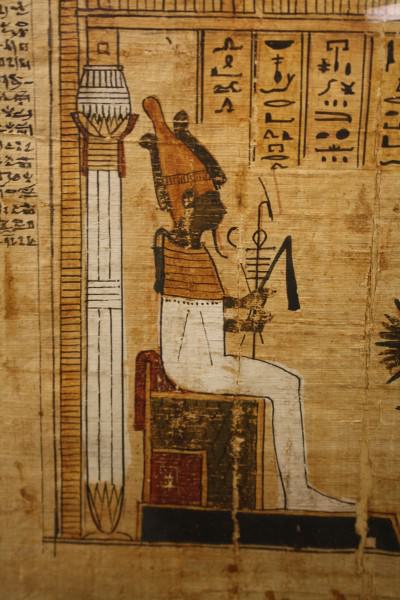
Book of the Dead of Tayesnakht
When a person died, they were guided by Anubis to the Hall of Truth (also known as The Hall of Two Truths) where they would make the Negative Confession (also known as The Declaration of Innocence). This was a list of 42 sins the person could honestly say they had never indulged in. Once the Negative Confession was made, Osiris, Thoth, Anubis, and the Forty-Two Judges would confer and, if the confession was accepted, the heart of the deceased was then weighed in the balance against the white feather of Ma'at, the feather of truth. If the heart was found to be lighter than the feather, the soul passed on toward paradise; if the heart was heavier, it was thrown onto the floor where it was devoured by the monster goddess Ammut and the soul would cease to exist.
Spell 125 begins with an introduction to the reader (the soul): "What should be said when arriving at this Hall of Justice, purging _____[person's name] of all the evil which he has done and beholding the faces of the gods." The spell then begins very clearly telling the soul exactly what to say when meeting Osiris:
Hail to you, great god, Lord of Justice! I have come to you, my lord, that you may bring me so that I may see your beauty for I know you and I know your name and I know the names of the forty-two gods of those who are with you in this Hall of Justice, who live on those who cherish evil and who gulp down their blood on that day of the reckoning of characters in the presence of Wennefer [another name for Osiris]. Behold the double son of the Songstresses; Lord of Truth is your name. Behold, I have come to you, I have brought you truth, I have repelled falsehood for you. I have not done falsehood against men, I have not impoverished my associates, I have done no wrong in the Place of Truth, I have not learnt that which is not...
After this prologue the soul then speaks the Negative Confession and is questioned by the gods and the Forty-Two Judges. At this point certain very specific information was required in order to be justified by the gods. One needed to know the different gods' names and what they were responsible for but one also needed to know such details as the names of the doors in the room and the floor one needed to walk across; one even needed to know the names of one's own feet. As the soul answered each deity and object with the correct response, they would hear the reply, "You know us; pass by us" and could continue. At one point, the soul must answer the floor about the soul's feet:
"I will not let you tread on me," says the floor of this Hall of Justice."Why not? I am pure.""Because I do not know the names of your feet with which you would tread on me. Tell them to me.""`Secret image of Ha' is the name of my right foot; `Flower of Hathor ' is the name of my left foot.""You know us; enter by us."
The spell concludes with what the soul should be wearing when it meets judgment and how one should recite the spell:
The correct procedure in this Hall of Justice: One shall utter this spell pure and clean and clad in white garments and sandals, painted with black eye-paint and annointed with myrrh. There shall be offered to him meat and poultry, incense, bread, beer, and herbs when you have put this written procedure on a clean floor of ochre overlaid with earth upon which no swine or small cattle have trodden.
Following this, the scribe who wrote the spell congratulates himself on a job well done and assures the reader that he, the scribe, will flourish as will his children for his part in providing the spell. He will do well, he says, when he himself comes to judgment and will "be ushered in with the kings of Upper Egypt and the kings of Lower Egypt and he shall be in the suite of Osiris. A matter a million times true." For providing the spell, the scribe was considered part of the inner-workings of the afterlife and so was assured of a favorable welcome in the underworld and passage on to paradise.
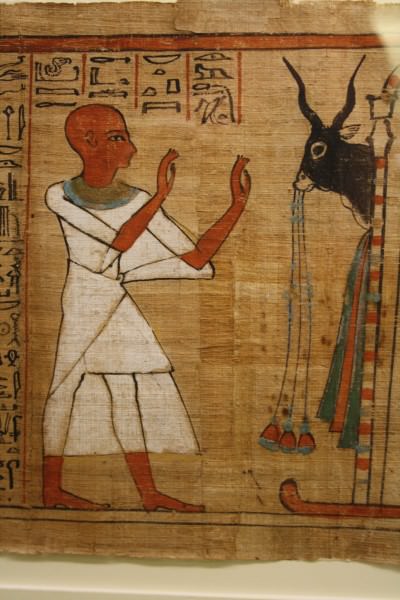
Book of the Dead of Aaneru
For the average person, even the king, the whole experience was much less certain. If one answered all of these questions correctly, and had a heart lighter than the feather of truth, and if one managed to be kind to the surly Divine Ferryman who would row the souls across Lily Lake, one would find one's self in paradise. The Egyptian Field of Reeds (sometimes called the Field of Offerings) was exactly what one had left behind in life. Once there, the soul was reunited with lost loved ones and even beloved pets. The soul would live in an image of the home they had always known with the exact same yard, same trees, same birds singing at evening or morning, and this would be enjoyed for eternity in the presence of the gods.
OTHER SPELLS & MISCONCEPTIONS
There were quite a number of slips the soul might make, however, between arrival at the Hall of Truth and the boat ride to paradise. The Book of the Dead includes spells for any kind of circumstance but it does not seem one was guaranteed to survive these twists and turns. Egypt has a long history and, as with any culture, beliefs changed in time, changed back, and changed again. Not every detail described above was included in the vision of every era of Egyptian history. In some periods the modifications are minor while, in others, the afterlife is seen as a perilous journey toward a paradise that is only temporary.At some points in the culture the way to paradise was very straightforward after the soul was justified by Osiris while, in others, crocodiles might thwart the soul or bends in the road prove dangerous or demons appear to trick or even attack.
In these cases, the soul needed spells to survive and reach paradise. Spells included in the book include titles such as "For Repelling A Crocodile Which Comes To Take Away", "For Driving Off A Snake", "For Not Being Eaten By A Snake In The Realm Of The Dead", "For Not Dying Again In The Realm Of The Dead", "For Being Transformed Into A Divine Falcon", "For Being Transformed Into A Lotus""For Being Transformed Into A Phoenix" and so on. The spells of transformation have become known through popular allusions to the book in television and film productions which has resulted in the misguided understanding that The Book of the Dead is some kind of magical Harry Potter type of work which ancient Egyptians once used for mystical rites. The Book of the Dead, as noted, was never used for magical transformations on earth; the spells only worked in the afterlife. The claim that The Book of the Dead was some kind of sorceror's text is as wrong and unfounded as the comparison with the Bible.
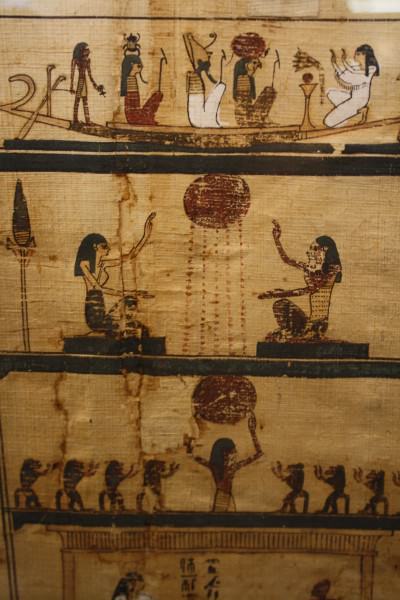
Book of the Dead of Tayesnakht
The Egyptian Book of the Dead is also nothing like The Tibetan Book of the Dead, although these two works are often equated as well. The Tibetan Book of the Dead (actual name, Bardo Thodol, "Great Liberation Through Hearing") is a collection of texts to be read to a person who is dying or has recently died and lets the soul know what is happening step-by-step. The similarity it shares with the Egyptian work is that it is intended to comfort the soul and lead it out of the body and on to the afterlife. The Tibetan Book of the Dead, of course, deals with an entirely different cosmology and belief system but the most significant difference is that it is designed to be read by the living to the dead; it is not a manual for the dead to recite themselves. Both works have suffered from the labels "Book of the Dead" which either attracts the attention of those who believe them to be keys to enlightened knowledge or works of the devil to be avoided; they are actually neither. Both books are cultural constructs designed to make death a more manageable experience.
The spells throughout the Book of the Dead, no matter what era the texts were written or collected in, promised a continuation of one's existence after death. Just as in life, there were trials and there were unexpected turns in the path, areas and experiences to be avoided, friends and allies to cultivate, but eventually the soul could expect to be rewarded for living a good and virtuous life. For those left behind in life, the spells would have been interpreted the way people in the present day read horoscopes. Horoscopes are not written to emphasize a person's bad points nor are they read to feel badly about one's self; in the same way, the spells were constructed so that someone still living could read them, think of their loved one in the afterlife, and feel assured that they had made their way safely through to the Field of Reeds.
Egyptian Papyrus › Antique Origins
Definition and Origins
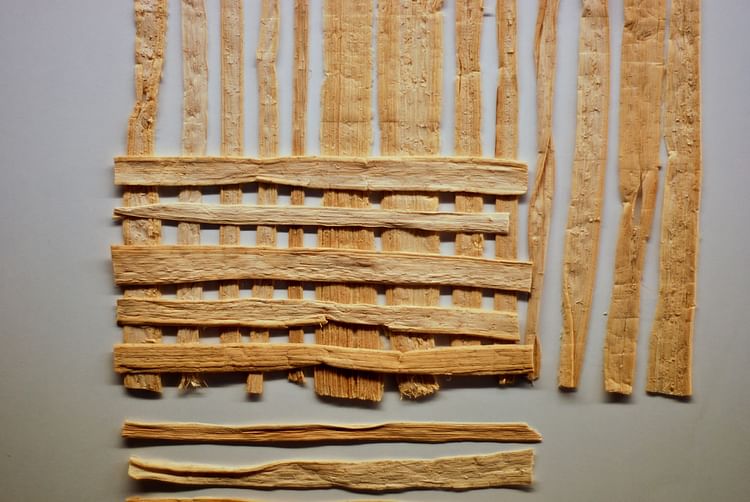
Papyrus is a plant ( cyperus papyrus ) which once grew in abundance, primarily in the wilds of the Egyptian Delta but also elsewhere in the Nile River Valley, but is now quite rare. Papyrus buds opened from a horizontal root growing in shallow fresh water and the deeply saturated Delta mud. Stalks reached up to 16 feet tall (5 m) ending in small brown flowers which often bore fruit. These plants once were simply part of the natural vegetation of the region, but once people found a utilitarian purpose for them, they were cultivated and managed in farms, harvested heavily, and their supply depleted. Papyrus still exists in Egypt today but in greatly reduced number.
The papyrus of Egypt is most closely associated with writing - in fact, the English word 'paper' comes from the word 'papyrus' - but the Egyptians found many uses for the plant other than a writing surface for documents and texts. Papyrus was used as a food source, to make rope, for sandals, for boxes and baskets and mats, as window shades, material for toys such as dolls, as amulets to ward off throat diseases, and even to make small fishing boats. It also played a part in religious devotion as it was often bound together to form the symbol of the ankh and offered to the gods as a gift. Papyrus also served as a political symbol through its use in the Sma-Tawy, the insignia of the unity of Upper and Lower Egypt. This symbol is a bouquet of papyrus (associated with the Delta of Lower Egypt) bound with a lotus (the symbol of Upper Egypt).
BESIDES WRITING, PAPYRUS WAS USED AS A FOOD SOURCE, TO MAKE ROPE, FOR SANDALS, AS WINDOW SHADES, MATERIAL FOR TOYS SUCH AS DOLLS, AS AMULETS TO WARD OFF THROAT DISEASES, & EVEN TO MAKE SMALL FISHING BOATS.
The plant may also be seen etched in stone on temples and monuments, symbolizing life and eternity as the Egyptian afterlife, known as the Field of Reeds, was thought to mirror the fertile Nile River Valley right down to the abundance of papyrus. The name 'Field of Reeds' actually refers to the reeds of the papyrus plant. At the same time, however, the papyrus thicket represented the unknown and the forces of chaos. Kings are regularly depicted hunting in the papyrus fields of the Delta to symbolize the imposition of order over chaos.
The dark and mysterious nature of the papyrus fields were frequently employed as a motif in mythology. Papyrus fields feature in a number of important myths; most notably that of Osiris and Isis after Osiris is murdered by his brother Set and Isis hides their child Horus in the marshes of the Delta. The papyrus reeds, in this case, hid the mother and child from Set's intentions to kill Horus and so again symbolize order prevailing over disorder and light over darkness.
NAME & PROCESSING
Papyrus is the Greek name for the plant and may come from the Egyptian word papuro (also given as pa-per-aa ) meaning 'the royal' or 'that of the pharaoh ' because the central government had control of papyrus processing as they owned the land and, later, oversaw the farms the plant grew on. The ancient Egyptians called the plant djet or tjufi or wadj, forms of the concept of freshness. Wadj further denotes lushness, flourishing, greenness. Once papyrus was cut, harvested, and processed into rolls, it was called djema which may mean 'clean' or 'open' in reference to the fresh writing surface.
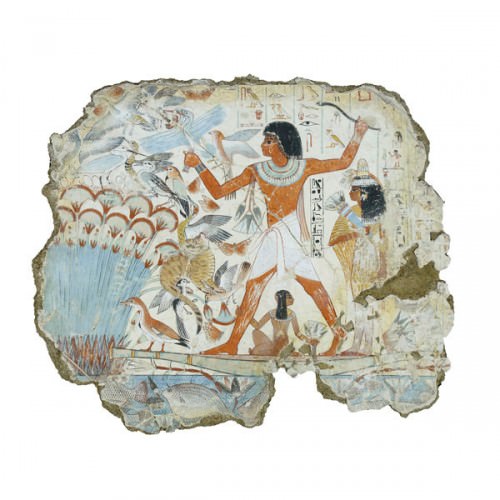
Nebamun Hunting in the Marshes
Papyrus was harvested from the beginning of the Predynastic Period in Egypt (c. 6000-c.3150 BCE) and continued to be throughout Egypt's history down to the Ptolemaic Dynasty (323-30 BCE) and into Roman Egypt (30 BCE - c. 640 CE). Field workers would harvest the plants from the marsh by cutting them at the bottom with sharp blades, bundling the stalks together, and carrying them to some conveyance which brought them to a processing center. Historian Margaret Bunson describes the process whereby the plants were made into workable sheets:
The stem of the papyrus plant was cut into thin strips which were laid side by side in perpendicular fashion. A solution of resin from the plant was laid down and a second layer of papyrus was put into place, horizontally. The two layers were then pressed and allowed to dry. Immense rolls of papyrus could be made by joining the single sheets...The sides of a papyrus where the fibers run horizontally are the recto and, where the fibers run vertically, the verso. The recto was preferred but the verso was used for documents as well, allowing two separate texts to be included on a single papyrus. (201)
Egyptologist Rosalie David adds to the description, detailing the stages of this process of forming the plants into sheets:
In the first stage, the stalk of the plant was sliced into pieces and the pith was cut out and beaten with a hammer to produce wafers. These were arranged side by side and crosswise in two layers and were then beaten into sheets. Then the individual pages were stuck together in the same way to form a standard roll of twenty pages;sometimes the rolls were stuck together as required to provide an even longer writing surface. After drying in the sun the full strip was rolled up with the horizontal fibers on the inside. This was the "recto" that would be written on first. (200)
The sheets, now joined into rolls, were then transported to temples, government buildings, the market or exported in trade.Although papyrus is closely associated with writing in general, it was actually mostly used only for religious and government texts because manufacturing costs were fairly expensive. Not only was the manual labor in the fields and marshes costly, it took skilled workers to methodically beat and process the plant without destroying it. All of the extant papyri are from temples, government offices, or personal collections of wealthy or at least well-off individuals. Written works often appear on pieces of wood, stone, or ostraca (shards from clay pots). The image of the Egyptian scribe hunched over his papyrus scroll is accurate, but long before he got his hands on that scroll, he would have spent literally years practicing writing on potsherds, chunks of stone, and pieces of wood.
USES & EXAMPLES
The scribes of ancient Egypt spent years learning their craft and, even if they were from wealthy families, they still were not allowed to waste precious material on their lessons. David notes that "the most common and cheapest writing materials were ostraca and pieces of wood. These were often used by schoolboys for their letters and exercises" (200). Only once one had mastered the basics of writing was one allowed to practice on a papyrus scroll. David notes how exercises found practiced on ostraca are sometimes duplicated on papyrus, which often supplies missing words or phrases to works which are incomplete in either form.
As a writing material, papyrus was used for hymns, religious texts, spiritual admonitions, letters, official documents, proclamations, love poems, medical texts, scientific or technical manuals, record-keeping, magical treatises, and literature.Extant scrolls range from fragments to one page to the famous Ebers Papyrus which is 110 pages long on a scroll sixty-five feet (20 metres) long. The Ebers Papyrus is a medical text which is routinely cited as evidence of how medicine and magic were interrelated in ancient Egypt. Along with other papyrus scrolls like the Kahun Gynaecological Papyrus, the London Medical Papyrus, and the Edwin Smith Papyrus, to name only a few, these works attest to the vast medical knowledge and skill of the ancient Egyptians and how they went about addressing major and minor injuries, various ailments, and serious conditions such as cancer and heart disease. Cases of anxiety, depression, and trauma are also dealt with in the medical texts of Egypt as are subjects like abortion, birth control, menstrual cramps, and infertility.
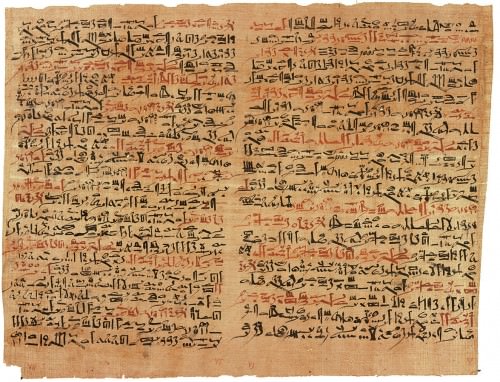
Edwin Smith Papyrus
Papyrus was also, of course, used for literary texts. The term 'literature' is commonly applied to an array of ancient Egyptian works from medical texts, royal decrees and proclamations, letters, autobiographies and biographies, religious texts, and others besides works of the imagination. A number of these works were inscribed in tombs, on temple walls, or on stele and obelisks while those which fit the common definition of 'literature' were written on papyrus. Some of the best known are The Tale of the Shipwrecked Sailor, The Report of Wenamun, and The Tale of Sinuhe, but there are many others.
Ancient Egyptian scribes wrote in black and red ink. Red was used for the names of demons or evil spirits, to mark the beginning of a new paragraph, for emphasis of a word or passage, and for punctuation in some cases. Scribes carried a wooden case which held cakes of black and red paint and a water flask to mix and dilute the paint into ink. The pen was initially a thin reed with a soft tip but was replaced in the third century BCE by the stylus, a more robust reed sharpened to a very fine point. A scribe would begin a work on the recto of the papyrus roll, write until it was filled, and then flip it over to continue the text on the verso. In some instances, a papyrus roll on which only the recto had been used would be taken by another scribe and used for another work, either complementary or completely unrelated.
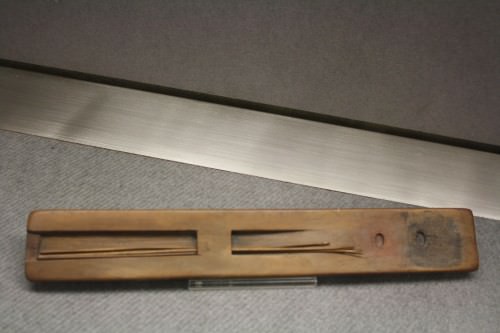
Egpytian Scribe's Palette
As noted, however, papyrus was not used exclusively for writing. The plant could be baked and eaten, and Herodotus reports that the papyrus root was a staple of the Egyptian diet. It was cut and prepared in a variety of dishes much as the later potato came to be in other cultures. Papyrus was not only a food source but leaned itself to an incredibly diverse range of uses. The earliest Egyptian skiffs were made by tightly weaving stalks of papyrus and binding them with rope, also made of papyrus. This technique created a light-weight water-tight boat which could easily be carried by hunters or fishermen. The papyrus skiff is featured in numerous tomb and temple paintings and has a markedly different, more linear, shape than later wooden boats built on the same design. Papyrus continued to be a significant aspect of the Egyptian boat even after wood replaced it as the primary material. When small wooden vessels were developed into large sailing ships, the plant was woven into ropes for the sails. Papyrus rope, however, was used for a number of purposes besides sailing and papyrus fiber, which was quite strong, proved useful in other products.
Mats and window shades were woven through a technique similar to that used to make writing material. The shafts of the plant were set down vertically and then woven with others horizontally and pulled tightly; they were then bound with a thinner fiber from the plant. Sandals were made by coiling the papyrus and were so sturdy that many examples of them have been found thousands of years after they were made still in good condition. Papyrus sandals required a great deal of skill to make and were too expensive for most people. Herodotus reports that the priests of Amun only wore papyrus sandals which, along with other evidence, scholars interpret as further proof of the priests' great wealth. Dolls or other toy figures were made by bunching up the stalks and then shaping them through tightly tied fibers to create a head, arms, and legs.
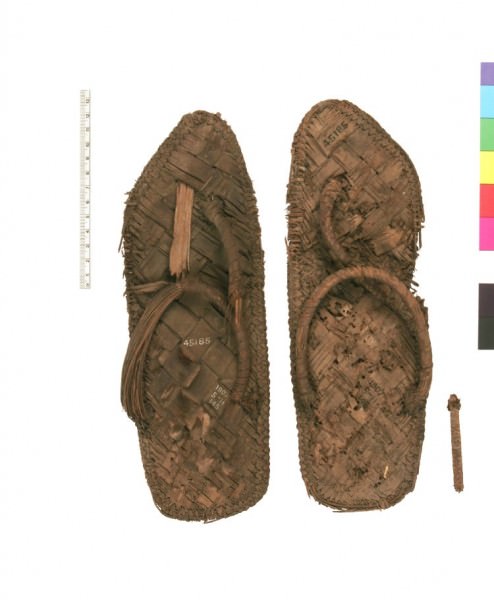
Papyrus Sandals
This "bunching" of the plant was employed in the creation of a popular offering to the gods: the shape of the ankh. The ankh, symbol of life and promise of life everlasting, was one of the most important icons of ancient Egypt and frequently placed with offering to the gods at temples or obelisks. Egyptologist Richard H. Wilkinson notes how "the ankh could be symbolized by floral bouquets and the 'papyrus swathe' (bundles of flowers and plant foliage tied around a central bunch of papyrus stalks) which was commonly offered to the gods" (161). This same technique was used in creating the Sma-Tawy symbol representing the unity of the country. The association of papyrus with unity and the gods is fitting in that the plant, like the gods and the gifts of the land, was an integral part of the people's lives.
LICENSE:
Article based on information obtained from these sources:with permission from the Website Ancient History Encyclopedia
Content is available under License Creative Commons: Attribution-NonCommercial-ShareAlike 3.0 Unported. CC-BY-NC-SA License